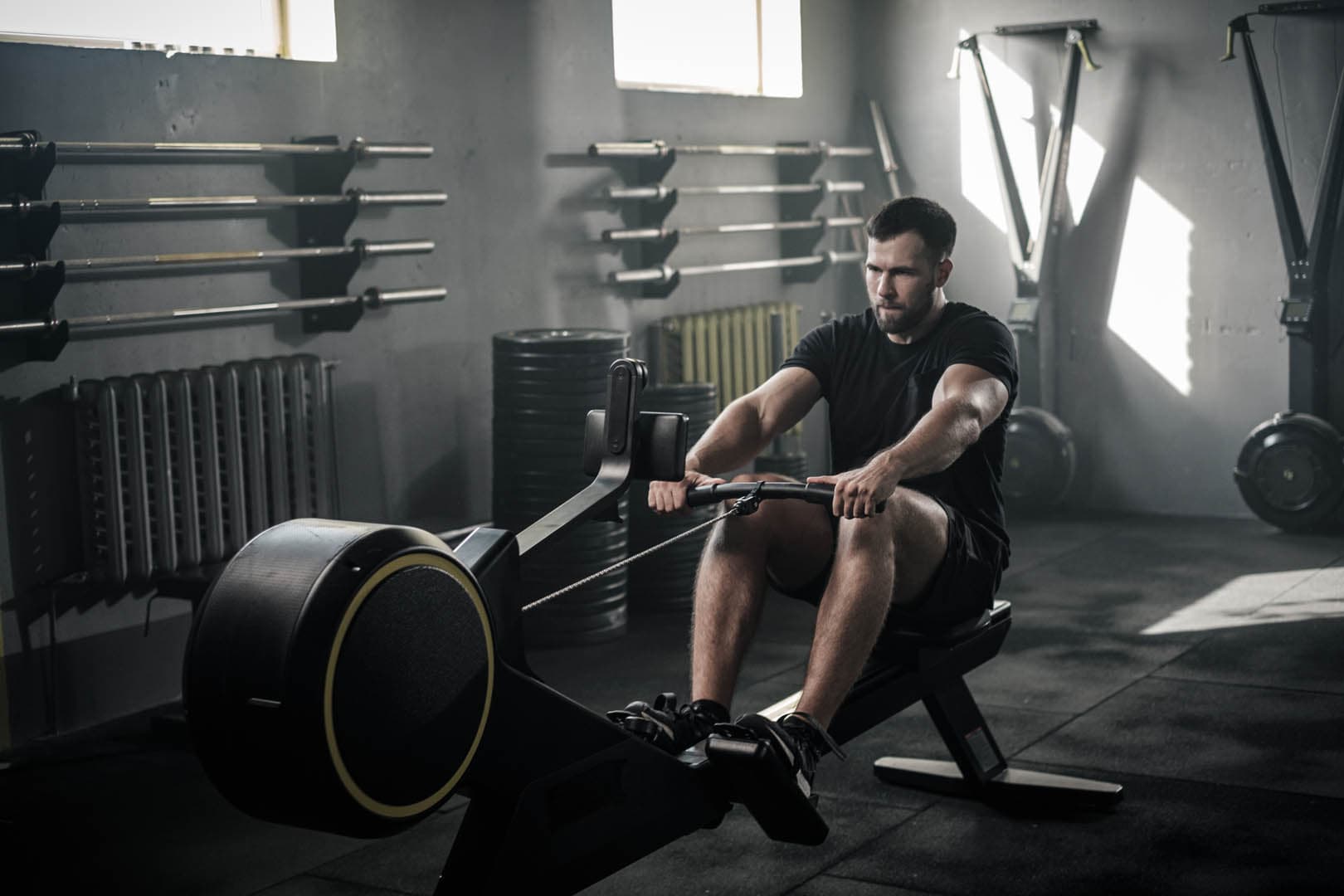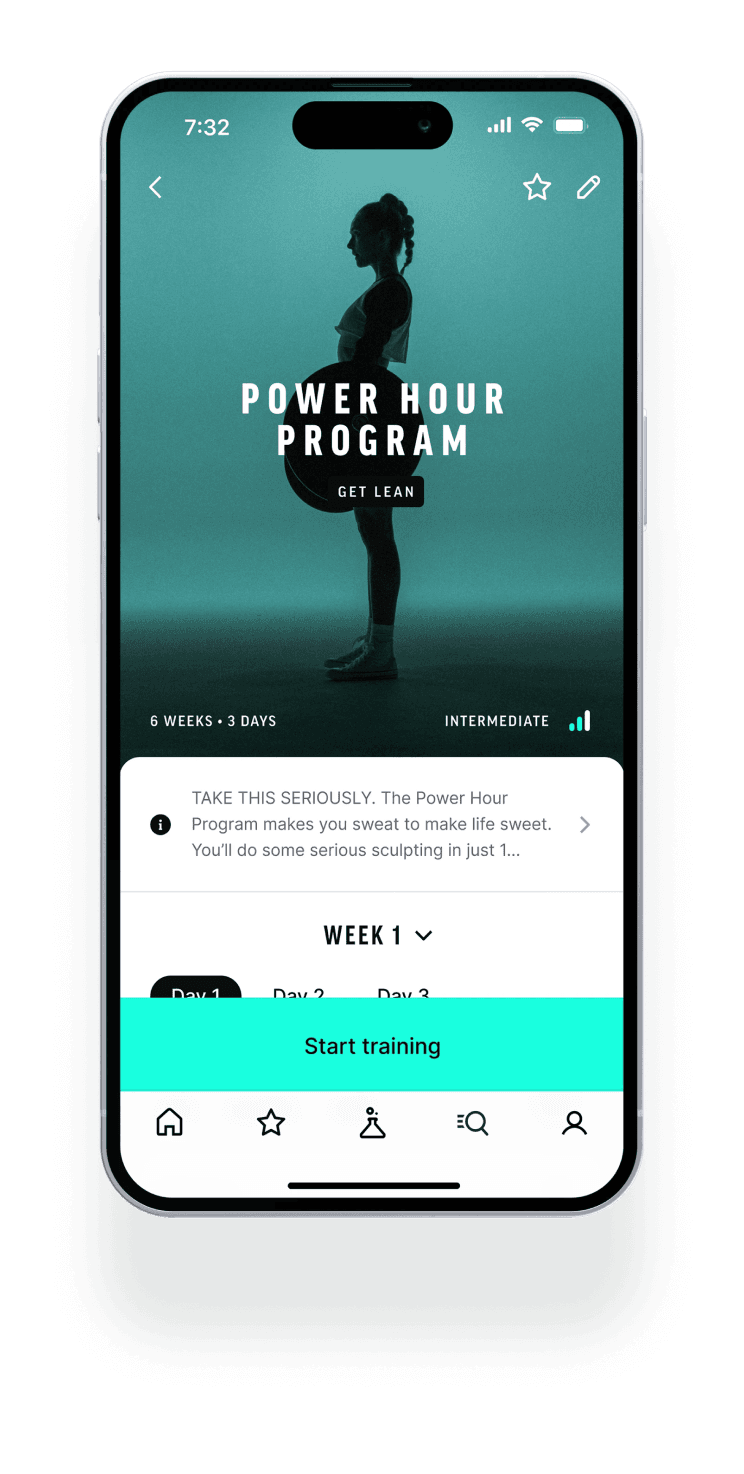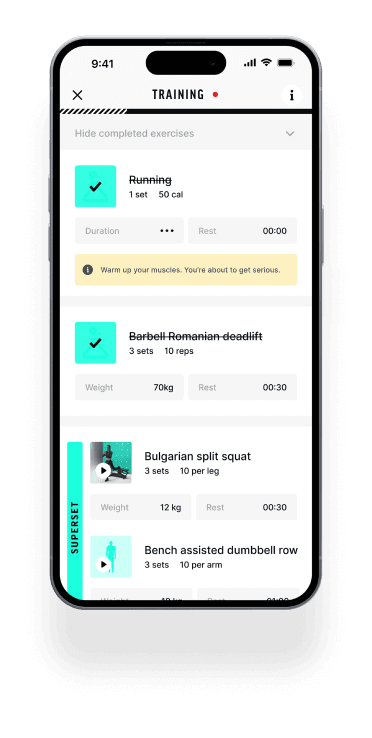How many calories do you burn during an hour of strength training?
By Sander Kers• August 17, 2023• 9 min•Nederlands 🇳🇱

How many calories do you burn during an hour of strength training?
How many calories do you burn during an hour of strength training? Calculating the calories burned during running or cycling is relatively easy. Those activities involve repetitive motions. Measuring calories burned during strength training is more challenging due to the variety of movements and the different weights people lift on the barbell.
Then there's the post-workout period, as your body needs to recover. The so-called afterburn. According to some, this post-exercise oxygen consumption (EPOC) phase is a calorie-burning heaven. Estimates from athletes vary from a few calories to at least 500 calories. To address the main questions of how many calories you burn with strength training and how much during the recovery period afterward, I've gathered 20 scientific studies. The surprising answers are outlined below.
Also read: Losing Belly Fat - 7 Super Tips
Calculating Calories Burned During Strength Training
Calculating the number of calories burned per training session is a daunting task. In fact, it's nearly impossible to calculate the exact number of calories for each training session and individual. Even the numbers on the smartest smartwatches are at best estimations with a significant margin of error. For many, calorie expenditure is a major reason for engaging in strength training, yet there has been relatively little research done on this topic. Here are a few cautious conclusions before delving deeper:
Men burn more calories per session than women.
Women burn around 100 to 150 calories during a light training session (low volume) and up to 300 calories during a heavy training session.
Men can burn up to 300-400 calories during a high-volume training session and around 150-200 calories during a light session.
There is an outlier reporting 840 calories burned in 34 minutes of training (though I have serious doubts about this study).
The immediate post-training calorie burn (EPOC) is negligible (8 to 30 calories).
Your resting metabolism can be elevated by 5% for 24-72 hours after an effective training session.
If you're looking to burn calories, endurance sports might be more effective.
Why Calorie Counting is Tricky for Strength Training
Measuring energy involves calories, kilocalories, or kilojoules. When we refer to calories, we often mean kilocalories (which is actually 1000 calories). The main question is how much energy you expend during an hour of strength training. This question seems straightforward at first, but numerous variables impact the outcome. Alongside factors like age, gender, body weight, lean mass, and height, you also have to consider:
total training volume
range of motion
duration of execution
rest intervals
isolation exercises vs. compound exercises
In short, calculating the exact number of calories burned per training session is virtually impossible. Let's start with the 5 key calorie variables, followed by estimations from scientific research.
Also read: Why Losing Weight and Maintaining It Is Seriously Hard.
Calorie Expenditure Variable #01 - Training Volume
The more weight you lift during training, the higher your energy expenditure typically is. The simplest way to calculate training volume is by multiplying the number of repetitions by the weight and the number of sets.
For example, consider the squat: 3 sets of 10 repetitions with 100 kilograms each:
10 reps x 100 kg x 3 sets = 3000 kg (volume)
10 reps x 100 kg x 6 sets = 6000 kg (volume)
Six sets require twice as much energy as three sets. This outcome is consistent across research whenever the number of sets for the same exercise is increased. More volume demands more energy. Getting up from the couch twice while Netflixing also burns more energy than getting up just once.
Now, let's say you do 10 sets of 10 repetitions with 30 kilograms for bicep curls, resulting in a volume of 3000 kg. The likelihood of burning the same amount of energy as with 3 sets of 10 reps of squats with 100 kilograms is very small. This is because the squat's range of motion is much greater than that of bicep curls, and more muscle fibers are engaged.
The same applies to the weight on the barbell. 10 reps with 150 kilograms require more energy than 10 reps with 100 kilograms.
In conclusion, higher volume leads to higher energy demand, and this demand varies per exercise. To accurately calculate the number of calories burned in a training session, you would need to know the energy demand per exercise. One of the reasons volume differs between exercises and even within an exercise is the range of motion.
Calorie Expenditure Variable #02 - Range of Motion
Consider this question: What requires more energy, assuming the weight is the same: A squat where you lower your hips below your knees (going "ass to the grass") for every repetition? Or a squat where you only go down 10 centimeters for each repetition?
I hope you chose option 1. Even though the theoretical volume is the same, the calorie expenditure is higher during a longer range of motion (deeper squat). In other words, even if the volume of an exercise is the same, there can be a significant difference in the amount of energy expended.
Exercise - High Barbell Squat

Calorie Expenditure Variable #03 - Duration of Execution
Experienced strength trainers expend more energy when performing an explosive squat compared to doing it in 2-3 seconds. For beginners, there is no significant difference. The faster you initiate a movement, the more energy you need to generate. Think of kicking a soccer ball. If you have a slow leg/foot movement, the ball will only roll a few meters. If you kick the ball explosively, it might travel dozens of meters forward. However, the weight of the ball remains unchanged. An explosive movement simply requires more energy because more muscle fibers are engaged. Conversely, intentionally performing an exercise very slowly (e.g., a 10-second squat) also demands more energy than your standard squat tempo. You need to exert force for 10 seconds to prevent the barbell from defeating you and succumbing to gravity.
Calorie Expenditure Variable #04 - Rest Intervals
Rest interval is a complex variable. At first glance, you might think that shorter rests result in more time spent burning energy. That's correct, but there's a tipping point. Performing an exercise with less rest often diminishes the intensity per set. You can test this yourself by doing the following circuit for 5 rounds without rest between exercises and then repeating it with 1-minute rest between exercises in the next training session:
Squat with 60 kg - max reps
Pull-up - max reps
Push-up - max reps
The number of repetitions and thus the training volume is clearly higher when you have 1 minute of rest between each exercise. However, this extends the duration of your workout by 15 minutes. If you have 0 seconds of rest and do fewer repetitions, you have an additional 15 minutes to burn calories with other exercises.
A shorter rest interval can reduce the number of repetitions and/or the weight on the barbell. A comparison between a bodypump class (practically no rest interval) and a relatively heavy strength training session (with 45-60 seconds of rest between sets) yielded the same calorie expenditure in a study involving women – around 300 calories. Another meta-analysis between circuit training and traditional strength training also didn't provide a clear winner.
Strategically applying rest in supersets (e.g., bench press followed by bent-over rows) can help you achieve a higher training volume in the same duration and thus burn more calories. However, if you perform 36 sets with supersets of two exercises in a one-hour session or 36 sets of the same individual exercises in 1.5 hours, with the same number of repetitions and weight on the barbell, you'll burn the same amount of calories.
Calorie Expenditure Variable #05 – Exercise Type
The more weight you lift, the more calories you burn. In general, compound exercises (squats, bench press, deadlifts, chin-ups, etc.) allow you to lift more weight than isolation exercises (dumbbell flies, bicep curls, leg extensions, etc.), and this is the main reason compound exercises have a higher energy demand. Compare bench press with flat dumbbell flyes. I don't know anyone who can lift a heavier weight during a fly compared to bench press, despite both being chest exercises. This is because bench press involves more moving joints than the fly. While a fly involves movement solely at the shoulder joint, bench press involves bending and extending the elbow as well. This allows the triceps to contribute to your bench press records. The more muscles involved, the more weight you can (probably) lift, and the more energy is required.
Energy Expenditure Varies by Training
I think the conclusion is pretty clear. It's impossible to pinpoint a fixed number of calories burned per training session. Even the smartwatches can only provide an approximate estimate at best. When everything is kept constant in a workout (number of sets, reps, weights, rest intervals), there's only one way to significantly increase energy expenditure... and that's by training longer (more exercises, more reps, or more sets). The longer you're in motion, the longer you're burning extra energy. Curious about the outcomes of various scientific studies?

Men in 'Real' Muscle Mass Training Burn about 350 Calories
There hasn't been much research done on the 'exact' number of calories you burn per strength training session. In my opinion, the most robust research was conducted in 2020 by João and colleagues. 15 men with an average 1-RM for squat of 103 kilograms and chest press of 93 kilograms engaged in a 'real' muscle mass training. 8 exercises of 3 sets to muscle failure with 75% of 1-RM weights (averaging about 10 reps per set) and 2 minutes of rest between exercises and sets. The exercises included:
chest press
pec deck
squat
lat pulldown
biceps curl
triceps extension
hamstring curl
crunch machine
A standard workout can easily consist of these exercises, and therefore, we men, at least, can benefit from the outcome. The total volume of the training averaged 15,000 kilograms (spread over 217 reps), and the training lasted for an hour. In doing so, the participants burned an average of 341 calories (ranging from 270 to 410 calories) above their normal energy expenditure. This means above the number of calories you would burn if you were doing nothing. The researchers tried to come up with some clever formulas, but they admit that these don't apply to all types of strength training and don't explain everything. Nonetheless, the good news is that men have a kind of guideline for a relatively strenuous workout!
Difference between Men and Women Lies Mainly in Strength
Training volume is a significant variable for the number of calories burned per strength training, and this variable mostly explains the difference between men and women. Men are generally stronger than women and, therefore, lift heavier weights. If a woman trains with the same weights as a man in the above-mentioned study, then the calorie count applies to her as well. However, in practice, the average female fitness enthusiast burns fewer calories. As you can see in the results of the next study.
161 vs 88 Calories – the Difference between Men and Women?
The research by Lytle and colleagues in 2019 compared energy expenditure from a similar training as in the previous study between 27 men and 25 women. The training setup was slightly less intense (2-3 sets with 70% 1RM for 7 exercises, at least 8 reps per set, 90-second rest between exercises, average total training duration of 51 minutes). The total training volume isn't mentioned in the study, but I estimate that the men performed between 8,000 and 12,000 kilograms of volume. These male participants are about 10-20% less strong compared to the men in João's study, perform 1 exercise less, and on average, half a set less for the other exercises (assumption). The women in this study have a 1RM that's 40-55% lower than the men's for almost all exercises, except for the leg press (33% lower).
In these workouts, the men burned an average of 161 calories above their resting metabolism (161 calories on top of the energy expenditure when not exercising), and women burned about 88 calories. The fact that women burned about half the energy can be largely explained by the difference in training weight. Additionally, they weigh on average 20 kilograms less and are 16 centimeters shorter than the male participants (and the latter contributes to a smaller range of motion).
The reason men in this training burned significantly fewer calories than in João's study (161 vs. 341 calories) is partly due to the lower training volume and corresponding duration. However, I think the volume difference is around 30%, definitely not half. Nevertheless, we're not certain whether the volume difference stems from exercise choices (which are almost the same), strength differences between participants, or differences in the equipment brands used, Gervasport vs. Keiser. An 80-kilogram lat pulldown can vary greatly between different equipment brands. Moreover, the method of energy calculation naturally affects the numbers. In short, even in studies, there's a variation in the number of calories burned.
7.43 Calories of Afterburn or a Bit More?
Before we delve into other studies, let's take a brief detour to EPOC, the official abbreviation for afterburn. EPOC is the extra energy expenditure after a workout. A workout demands a lot from your body. Your heart rate increases, more muscles are active compared to when at rest, your breathing rate goes up, and many other changes occur. After a workout, your body wants to return to its resting state as quickly as possible. To restore all processes to normal after a workout, your body requires some extra energy. The study by Lytle (the one about 161 vs 88 calories) reported a super-high afterburn score after training of, brace yourselves, a whopping 7.43 calories. Quite a number, right? In other words, after a workout, you burn an additional 7.43 calories to get back to your regular routine. That's not even a small bite of a cookie. Even in other studies (for instance, 1, 2, and 3), you'll find only small EPOC numbers ranging from 20 to 35 calories. Moreover, the total training volume in this research (10,000 vs. 20,000 kg) has no impact on the amount of EPOC.
In summary, the notion that strength training or interval training leads to the burning of hundreds of extra calories immediately after the workout is quite an overstatement.
Higher Metabolism and Calorie Expenditure 24-72 Hours after Training
A bit of muscle soreness after a workout, who doesn't know it? A good training session is followed by a period of adaptation by your body. Your body responds to the feedback from a good workout. If you've indicated that you want larger muscles, your body starts working on that. If you aim for better endurance, your body needs to make some adjustments. In essence, on average, 24 to 72 hours after a workout, your body is still adapting to the training. Naturally, this requires extra energy. The amount naturally varies from person to person and training to training, but this study demonstrates a significant increase in daily energy expenditure of 5% (up to 72 hours after a workout). If you normally burn around 2500 calories a day, after a good workout, you might burn up to 2625 calories. This might sound like music to the ears of those aiming to lose weight, but the days after a workout, your body also demands more energy in the form of additional food.
Rule of Thumb: 23 Calories per 1000 Kilograms of Volume
The research by Abboud aligns with the '15,000-kilogram study by João.' João concluded that approximately 341 calories are associated with a training volume of 15,000 kilograms. Abboud's results show that 8 trained men needed about 247 calories for 10,000 kilograms of volume and about 484 calories for 20,000 kilograms. In other words, these figures perfectly align with the 341 calories for 15,000 kilograms.
If we were to take an average of these results (but don't declare this as the ultimate number, because it doesn't exist), then you need about 23 calories per 1000 kilograms. If we add the 161 calories from Lytle's study, we end up with roughly 21 calories per 1000 kilograms.
Burning 1400 Calories per Hour?!?
If I had written this article in June 2021, the consensus would have been that you burn quite a few extra calories during a strength training session. Not an insane amount, as some might think. Probably on the lower side. However, in July 2021, a study was published that disrupts all previous observations. Let's scrutinize the research by Adeel and colleagues, as I have a feeling that something here doesn't quite add up. Firstly, they compared 5 untrained athletes (60% 1RM deadlift of 31 kilograms) with lightly trained athletes (60% 1RM deadlift of 56 kilograms). The initial conclusion aligns with the earlier mentioned studies. Trained athletes (lifting heavier weights) burn more calories per training session. On average, 14% more. Now, the incredibly surprising figures:
3 sets of deadlifts with 10 reps at 31 kilograms costs untrained athletes 240 calories, and lightly trained athletes 275 calories. That's for 930 kilograms (3x10x31) and 1680 kilograms of volume, respectively. So, 3 sets of 10 reps at 31 kilograms (a volume of 930 kilograms). The energy expenditure is over 10 times higher than in the previously mentioned studies.
If, in a session, you perform 3 sets of deadlifts, 3 sets of bent-over rows, and 3 sets of lunges, you could burn up to 840 calories (for lightly trained athletes). This is what Adeel and colleagues claimed. These are 9 relatively light sets in exchange for 1/3 of your daily energy requirement. I'm willing to say that this doesn't add up.
1400 Calories vs. 3.3 METs
The doubts about this study continue. If a set of deadlifts with 10 reps at 56 kilograms costs almost 100 calories, then the MET score must be exceptionally high. MET stands for how much energy something costs. 1 MET is the amount of energy you expend while doing nothing, just lounging on the couch and watching Netflix. A rough rule of thumb is that the calories burned per hour for 1 MET are about equal to your body weight in kilograms. For an 80-kilogram individual, 1 MET is equivalent to 80 calories per hour. Doing nothing for 24 hours would cost you 1920 calories. Walking at 4.8 km/hour equates to 3.3 METs. If an 80-kilogram person walks for an hour, it burns 264 calories. That's 184 calories more than Netflix and chill on the couch.
Now comes the twist. The training sessions in which participants supposedly burned 840 calories were assigned a METs rating of 3.3 by the researchers. The same as walking at 4.8 km/hour. Let's do the math. These 840 calories were burned in just 34 minutes (9 sets with an average duration of 40 seconds and 3 minutes of rest between sets). If we convert this to an hour, then you burn 1400 calories! And all this at 3.3 METs? Impressive. If we reverse-calculate 1400 calories per hour to the METs for an 80-kilogram person, we end up with 17.5 METs. The METs table in my book only goes up to 16, which equates to running at 16.1 km/hour for an hour. Try that...
Unusual Reference List
Looking at the reference list for the 1400 calories per hour article, I've noticed that none of the aforementioned studies are included. Not a single one! Even though these studies are directly relevant to the whole calorie story of this study. This, to put it mildly, strikes me as odd. If you ask me, this study confirms that you should never base your opinion on just one article.
Do You Really Want to Burn Calories? Engage in Endurance Training
You don't do strength training for the calories. You do strength training to become stronger, more muscular, fitter, more stable, more flexible, and so on. Strength training consumes energy because you're moving weights (sometimes heavy ones). Strength training is fantastic for leading a more vital life, but it's not a significant calorie burner. Compared to Netflix and chill, strength training is an energy-consuming monster. However, compared to an endurance sport like running, it's not that impressive. When running, you burn, as a rule of thumb, about the same number of calories per kilometer as your weight in kilograms. Someone weighing 80 kilograms burns around 80 calories per kilometer of running. If you manage to run continuously for 10 kilometers, you might burn about 800 calories (assuming you weigh 80 kilograms). There's no strength training session that can compete with that. Naturally, during 10 kilometers of uninterrupted running, there's no rest. In a strength training session, the majority of the time is spent resting.
Conclusion – Strength Training is Great for Everything and Moderate for Burning Calories
FAQ - Burning calories during fitness
How many calories do you burn during 1 hour of strength training? The number of calories burned during 1 hour of strength training varies between 100 and 400, depending on factors such as intensity, exercise selection, range of motion, and body weight.
How many calories do you burn with 30 minutes of strength training? During 30 minutes of strength training, you can burn approximately 50 to 200 calories.
Can you burn fat with strength training? Yes, strength training can promote overall fat burning, but cardio training and nutrition are more effective variables for losing fat mass.
How many calories do you burn with 45 minutes of strength training? On average, you can burn 75 to 300 calories during 45 minutes of strength training.
What is better for weight loss, cardio or strength training? A combination of cardio and strength training is more effective for weight loss, with cardio providing immediate calorie burning and strength training slightly boosting metabolism in the long term.
How long does it take to see weight loss results from strength training? Results from strength training for weight loss vary, but positive changes can take a few weeks to months. However, it's important to note that strength training is not primarily focused on weight loss.
Which strength training is effective for burning belly fat? There is no specific strength training to target belly fat, but exercises like squats, deadlifts, and lunges contribute to overall fat reduction due to their higher energy expenditure. Again, focusing on your diet and engaging in endurance training is more effective for fat burning.
START TRAINING SERIOUSLY
Discover new training methods based on scientific knowledge, improve your form and technique and seriously track your fitness goals.


Scan the code on your phone to download the app in the Apple appstore.

Of gebruik seriousfitnesslab.com/download